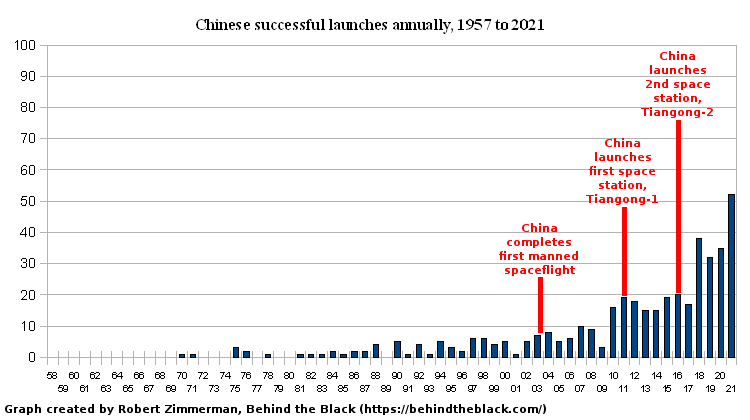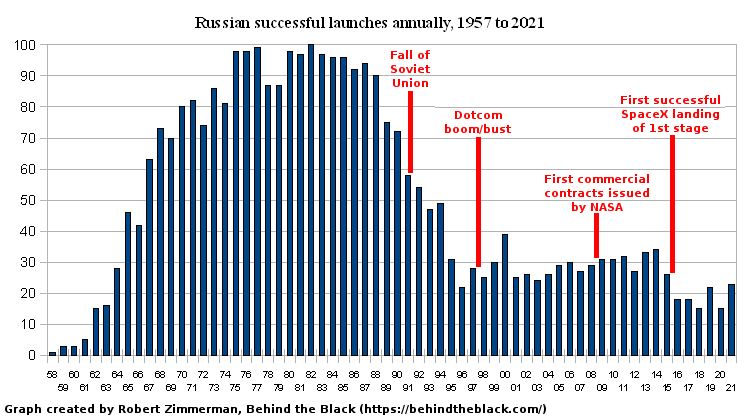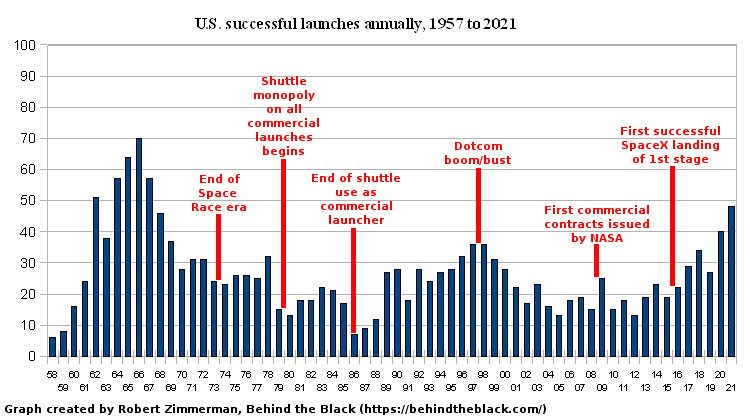2021: The year that private enterprise took over rocketry
The year that just ended, 2021, was for the field of rocketry the most successful year since the launch of Sputnik in 1957. In a year when the world was still racked by COVID panic and its oppressive restrictions on both private and public life, the global launch industry was able to rack up the most launches ever, successfully completing 134 launches and topping the previous best year, 1975, by one.
The chart below shows all successful launches by every nation in the 21st century. It also shows in the U.S. the breakdown of those launches by private companies.

Note the numbers in the red box. When the year started most of the various private companies and nations each predicted the number of launches they would attempt in 2021. As is usual, many of those predictions were overstated (such as ULA, Blue Origin, Virgin Orbit, Russia, and India). For many years this pattern was typical, with almost no one matching their predicted totals at the end of the year.
What made 2021 different from past years was that in two cases the prediction was beaten. SpaceX had said it would attempt 29 launches. Instead, it topped that by two, completing 31 launches with no failures. This number was also a new record for SpaceX, being the most launches ever by a private company in a single year. In fact, it topped the totals for the entire U.S. for most of the 21st century.
China in turn demolished its prediction of 40 by launching 52 times successfully, with three failures. The total also demolished its previous record for the most launches in a single year, 35 set in 2020.
At the start of the year the total prediction of 162 launches seemed not only unlikely but wildly unrealistic. In the end however it was not only realistic but not really much more than the 134 launches that actually succeeded.
This phenomenal record was achieved because of two factors, international competition and private ownership.
International competition
No longer is the watchword in space “cooperation.” Instead, countries are trying to stake out their own territory, working competitively. The result is the most action in rocketry since the first space race in the 1960s.
In 2021 China made it clear that it is entirely serious about the exploration of space, successfully putting landers and rovers on both the Moon and Mars and beginning the aggressive assembly of its own manned space station. The graph below, showing the growth of China’s space effort in the 21st century, makes this evident.

It also has a long term and very well-thought-out plan for its future program of exploration, which includes manned missions to the Moon, sample return missions to Mars, and eventually manned missions to the Red Planet. And because it is also using its space program as a training ground for future high level political leaders, do not expect this policy to change much should the present Xi regime fall. A large percentage of its political leaders cut their teeth pushing space exploration, and are likely to continue to support it no matter who is in charge.
Russia meanwhile showed in 2021 that its effort in space is continuing to stabilize, maintaining a steady launch pace since major quality control problems almost shut its operations down in 2018.

Though it lost most of its commercial satellite business to SpaceX, it still has one major satellite customer, OneWeb. It also is making money launching tourists to ISS, where it is successfully competing with the new American space tourism industry. For Russia the international cooperation is fueling a revival in space. We would make a mistake if we underestimate its potential in the coming decade.
While both India and Europe failed to meet their launch predictions, both did so almost entirely because of their panic over the Wuhan flu. Both remain in the game, with India pushing the hardest to compete against the American commercial private launch companies that are cutting launch costs and grabbing market share. The Modi government in India is trying to transition from a government-run space program to one controlled and owned by private companies, in the belief that private ownership and competition will energize their aerospace industry, as it has in the U.S.
Europe’s future in space is more problematic. Its new rocket, Ariane-6, costs too much and has not attracted much business. Several private rocket companies are appearing in Germany and Italy, but it remains unclear if the European Union and Europe’s space bureaucracy will allow these to develop independently. If they do, Europe will compete. If not, it is unknown if Europe’s subsidized operations under Arianespace can do the same. Its history is not good, as it has never made a profit even though for most of the 21st century — until SpaceX came along — it held about a 50% market share in commercial launches.
Even so, that Europe might find itself left behind as other countries surge forward in space is likely to force it from the doldrums. It was this fear that forced it several years ago to restructure Arianespace to put private companies in charge — under the name ArianeGroup — rather than Arianespace’s government bureaucracy. A failure to compete might force further changes that will enliven Europe’s aerospace industry.
Meanwhile, both Japan and South Korea are developing new rockets. Japan is trying to emulate the U.S. by pushing its private companies to build cheaper rockets, with both Mitsubishi and Honda doing so. Whether these new rockets are competitive and can garner customers remains to be seen.
South Korea appears to want to emulate India’s long held policy of using its government space agency to lead the development of a new national rocket that can then compete on the open market. At a minimum this will put this country into space in the next year or so.
All in all, peaceful international competition is generating far more success and innovation than decades of international cooperation. We need only look at the graph below, showing the overall launch trends since the launch of Sputnik. Since 2004 the number of successful launches year by year has steadily grown, fueled greatly by the competition that China has brought to the international space effort.

With this success in mind, policy makers must resist the calls for international cooperation that will invariably come from academics and government bureaucrats in the coming years. Cooperation might sound wonderful, but in the end all it accomplishes is to stifle achievement and growth, as the graph shows after the fall of the Soviet Union when international cooperation became the goal in space.
Instead, we must let many space stations and rockets bloom, from many different countries.
Private ownership
All this international competition has been fed primarily by the U.S.’s slow transition in the past decade from a government-run top-down space program — with everything owned and built by that government — to a private and chaotic aerospace industry, whereby everything is owned and built by competing private companies, and the government is merely a customer buying what it needs from the open market. The graph below illustrates mightily the success of this change in policy.

For the United States, 2021 saw the most launches since the height of the 1960s space race. And we should expect that record to be topped in 2022, as several new rocket companies begin operations.
This switch to private enterprise was essentially completed in 2021. Except for NASA’s very questionable SLS rocket, which by the way did not launch in 2021 as NASA had predicted, almost all of America’s space exploration effort has shifted to private enterprise. While NASA still builds planetary probes, even here it is shifting to buying the landers and rovers from private companies. In the coming years, as the planetary probes of these private companies begin to pile up successes, expect NASA and others to begin buying everything from the private market.
We thus have the most vibrant American aerospace industry in a half century, with many different competing companies, led by SpaceX. For example, SpaceX is about to launch a heavy-lift re-useable rocket, Starship/Superheavy, that has taken it only four years to build for less than a tenth what it has cost NASA to build SLS. Unless the government decides to step in and squelch SpaceX’s effort, private enterprise could very quickly make the colonization of the entire solar system both possible and affordable, for everyone.
Meanwhile, the U.S. now has three smallsat rocket companies in operation, Rocket Lab, Virgin Orbit, and Astra. In addition, five others are aggressively developing new rockets, with several on the verge of their first launch. By the end of 2022 these smallsat rocket companies could all be launching regularly.
Not all is sweetness and light of course. Competition and freedom always includes risk. Some of these new companies will certainly fail. The demand for launch services might not be enough to sustain them all. And factors outside the control of anyone, such as war and further panics like the Wuhan panic, could shut them all down.
That they exist, however, and that they are all about to launch, suggests the future is bright indeed for the American effort to explore and settle the solar system. We might be faced with stiff competition from China, but that does not mean the U.S. is not in the game. If anything, its free market market approach, fueled by that magic word freedom, puts the U.S. in the strongest position of all. With many competing independent companies, no one person or government agency can easily shut the U.S. effort down. If one fails, others will take its place.
And as the competition for success in space heats up, both by the private and international entities, the independence and freedom of American companies to innovate to address that competition is certain to keep the U.S. ahead of others.
We need only allow freedom to rule to make it happen.
On Christmas Eve 1968 three Americans became the first humans to visit another world. What they did to celebrate was unexpected and profound, and will be remembered throughout all human history. Genesis: the Story of Apollo 8, Robert Zimmerman's classic history of humanity's first journey to another world, tells that story, and it is now available as both an ebook and an audiobook, both with a foreword by Valerie Anders and a new introduction by Robert Zimmerman.
The print edition can be purchased at Amazon or from any other book seller. If you want an autographed copy the price is $60 for the hardback and $45 for the paperback, plus $8 shipping for each. Go here for purchasing details. The ebook is available everywhere for $5.99 (before discount) at amazon, or direct from my ebook publisher, ebookit. If you buy it from ebookit you don't support the big tech companies and the author gets a bigger cut much sooner.
The audiobook is also available at all these vendors, and is also free with a 30-day trial membership to Audible.
"Not simply about one mission, [Genesis] is also the history of America's quest for the moon... Zimmerman has done a masterful job of tying disparate events together into a solid account of one of America's greatest human triumphs."--San Antonio Express-News


Great article, Robert. Free enterprise will lead the way. It will be really interesting to watch India and Japan and their effort at introducing free enterprise into their space programs.
Eventually the Chinese space program will look like Russia’s does today.
• Centralized economies ALWAYS collapse.
• On the other hand the godless Chicom commies have vast numbers of American government and corporate leaders on their payroll transferring trillions of dollars from America to China to keep the CCP Ponzi scheme afloat.
• On the other hand in killing America the godless Chicom commies are killing the goose that lays their golden eggs.
Hard to say how long the CCP survives. The Soviet Union lasted for decades.
James,
Every once in a while I see writers note how much the Chinese people love their government. The Chinese Communist Party is the Chinese government. The CCP membership is 6.7 pct of the population. The people who actually run things likely are .1 pct of that 6.7 pct. 95 million people out of 1.4 billion. I can’t imagine the 93.3 pct of the non party membership loves a government in which they have zero say.
I’m sure the CCP leadership has to be in terror that even a 10 pct of the population decides they want things to change.
Hey Bob – thanks for the work you put into this Launch year in review post. For all the Space Journalists & Space YouTubes out there, I don’t think there is anyone else who does this detailed tracking of the global launch industry.
In a future post, for the 134 global launches, could you provide a best guess percentage using the following categories?
Military
Civilian
Orbiting Space Stations
Moon missions
Astronomy
Planetary/Solar System Exploration
In other words – for what purposes is humanity competing in Space?
Second question – besides Military, which of the above categories will countries focus their resources on this decade?
Here is an interesting opinion piece by Glenn Reynolds regarding the US – China competition that supplements your excellent analysis of that topic:
https://nypost.com/2021/12/02/america-is-behind-in-space-race-china-is-determined-to-win/
And for those interested in comparing 2020 to 2021, here is the link your 2020 analysis:
https://behindtheblack.com/behind-the-black/essays-and-commentaries/the-state-of-the-global-rocket-industry-in-the-21st-century/
Szczęśliwego Nowego Roku i spraw, by eksploracja kosmosu znów była świetna!
Happy New Year and make Space Exploration Great again!
Gary, I agree. If you’re one of the obedient cogs in the CCP machine and maintain a high social credit score then life in China is sweet. I’ve noticed almost everything I’ve bought lately is made in China. On the surface what’s happened in the last 20 years really is an amazing success story.
I take everything I hear out of China with large dose of skepticism. Like a couple weeks ago I read the CCP isn’t a unified party and President Xi changes where he sleeps 3 times a night to throw off assassination attempts. Maybe. Capitalism was really blossoming in China but a year ago Xi severely cracked down on unofficial mom & pop businesses. Jack Ma, founder of Alibaba, has been missing for a couple years after he bragged about his success and criticized the government.
And then there’s this… an 8 minute Tucker Carlson video from December 2020 of a Chinese professor saying that China “has people at the top of America’s core inner circle of power & influence.” The Chinese audience laughs. I get so angry listening to it I have to take it in small doses.
Tucker Carlson’s Monologue on a Chinese Professor’s Recent Speech Should Terrify You
https://pjmedia.com/news-and-politics/stacey-lennox/2020/12/08/tucker-carlsons-monologue-on-a-chinese-professors-recent-speech-should-terrify-you-n1197202
China’s space and manufacturing sectors are shining stars. The rest of the country is hanging on by a very thin thread.
Gary / James–
yeah– there are roughly 90 million hard-core cadre members who run the criminal gulag state known as China. They will eventually have to go, all the way.
“What Is State Capitalism”
https://www.capitalism.org/collectivism-statism/state-capitalism/
Jordan Peterson
“Correlation Between Prevalence of Infectious Diseases & Authoritarian Belief”
[excerpted from: 2015 Personality Lecture 14: Existentialism, Solzhenitsyn, Intro to Biology & Psychometrics]
https://youtu.be/yO6VfFqvRkM
8:38